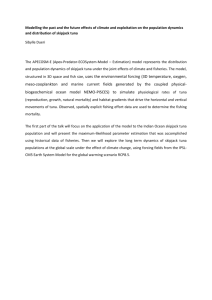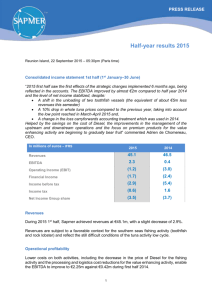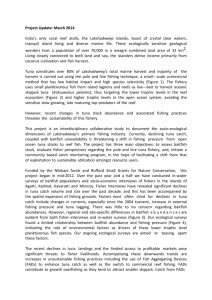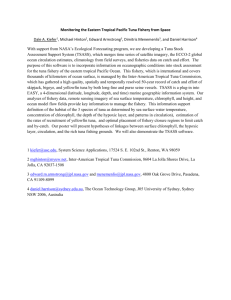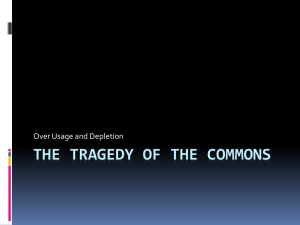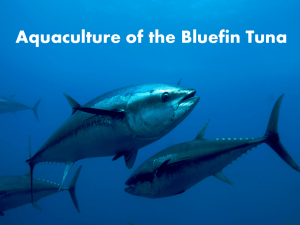glenn-hurry_Effectiveness-of-CMM-Glenn-Hurry
advertisement
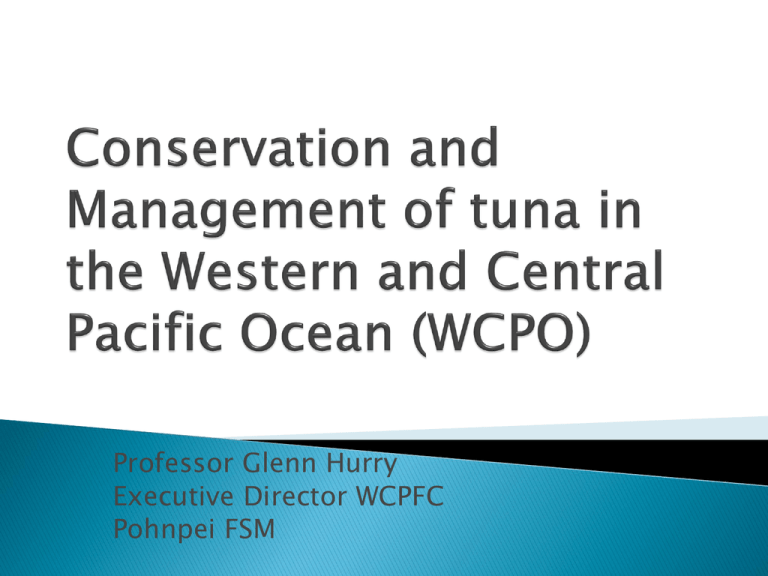
Professor Glenn Hurry Executive Director WCPFC Pohnpei FSM Three themes for today: ◦ The WCPFC and its current challenges ◦ The Philippines tuna industry as part of the WCPO ◦ Key issues ◦ What might the future international fisheries management environment look like for the WCPO? 43 Member and cooperating non member countries WCPO 55% of the worlds tuna catch PNA 40% of worlds canning tuna 80% of catches from EEZ’s Tuna fisheries provide significant income to PIC&T’s Fisheries still in reasonably good shape Develop a replacement measure for CMM 2008/01-2011/01 for bigeye, yellowfin and skipjack tuna…allocation? Need to develop harvest strategy and target/limit reference points (Critical) Effective control of Southern Albacore Management of Sharks Improve Observer program Overlap area and shared responsibilities with IATTC Is this the spawning ground for the Pacific Philippino Catch history Obligations under the CMMs Data Collection Skipjack Bigeye Larval sampling (Nishikawa et al, 1985) Modelled larval distributions 1 year loop animation (Mar 2010-Feb 2011) of predicted skipjack larvae distribution (resolution ¼°x weekly) Note: 2010 was a La Niña year This CMM shall apply to Philippine traditional fresh/ice chilled fishing vessels operating as a group. This measure shall apply only to High Seas Pocket no. 1 (HSP-1), Philippines shall require its concerned vessels to submit reports to the Commission at least 24 hours prior to entry and no more than 6 hours prior to exiting the HSP-1 SMA. The fishing vessels covered by this measure shall employ a regional observer on board during the whole duration while they operate in HSP-1 SMA in accordance with the provisions of CMM 200701. The covered fishing vessels shall be equipped with and operate an automatic location communicator (ALC) pursuant to CMM 2007-02 The total catches of these vessels shall not exceed equivalent to validated vessel days fished in the high seas. The Philippines shall limit its fleet to 36 fishing vessels (described by the Philippines as catcher fishing vessels) in the HSP-1 SMA. Philippines contribution to the total WCPFC Area Tuna catch 3,000,000 Other Fleets Catch (metric tons) 2,500,000 2,000,000 1,500,000 1,000,000 500,000 0 Philippines Fleets Philippines contribution to the total WCPFC Area PURSE SEINE tuna catch Catch (metric tons) 2,000,000 1,800,000 Other Fleets 1,600,000 Philippines Fleets 1,400,000 1,200,000 1,000,000 800,000 600,000 400,000 200,000 0 Philippines Fleet catch in the WCPFC Area by GEAR category 400,000 350,000 Other gears (municipal) Catch (metric tons) Purse seine domestic-based 300,000 250,000 200,000 150,000 100,000 50,000 0 Purse seine (bilateral) Philippines Fleet catch in the WCPFC Area by Oceanic Tuna SPECIES 400,000 350,000 Bigeye tuna Catch (metric tons) Yellowfin tuna 300,000 250,000 200,000 150,000 100,000 50,000 0 Skipjack tuna Why collect data ? 40S 20S 0 20N 40N Tuna don’t recognise man-made boundaries – they are “highly migratory” species - so stock assessment and management must be done on a regional, and sometimes ocean-wide, basis 120E 140E 160E 180 160W 140W 120W 100W 80W Long-distance (>1,000 nmi) movements of tagged skipjack. Tuna don’t recognise manmade boundaries – they are “highly migratory” species - so stock assessment and management must be done on a regional, and sometimes ocean-wide, basis RFMO structure RFMO’s and Industry Sustainability Population trends Resource access The impact of meetings on PICT’s: WCPFC, IATTC, SPC, FFC, PNA, TVM Is there a better model: ◦ consolidate some meetings? ◦ ocean basin management, larger more cost effective multi-species RFMOs Consensus based decision making Making RFMO’s accountable to civil society Partnerships in RFMO’s: governments, science, industry, NGO’s Companies fish not countries Multi-national companies and fleet structure Be careful what you ask for. ◦ Investment requires stability ◦ Long term profitability requires sustainability ◦ Short term gain…..long term pain Potential technical/ harvesting solutions could come from industry Strong fishing industry organisation? Demographic changes Food security… emerging debate Good fisheries data Climate change FADs Certification and Traceability World population: 7 billion (2012)9.3 billion (2050) Further demand for seafood, prices ◦ Added pressure on stocks Who will our main fishing nations be? ◦ Old world – new world fleets Multi nationals companies vs flag control Joint ventures for better returns Food security and food affordability Social considerations in harvest control rules Improved RFMO decision making
